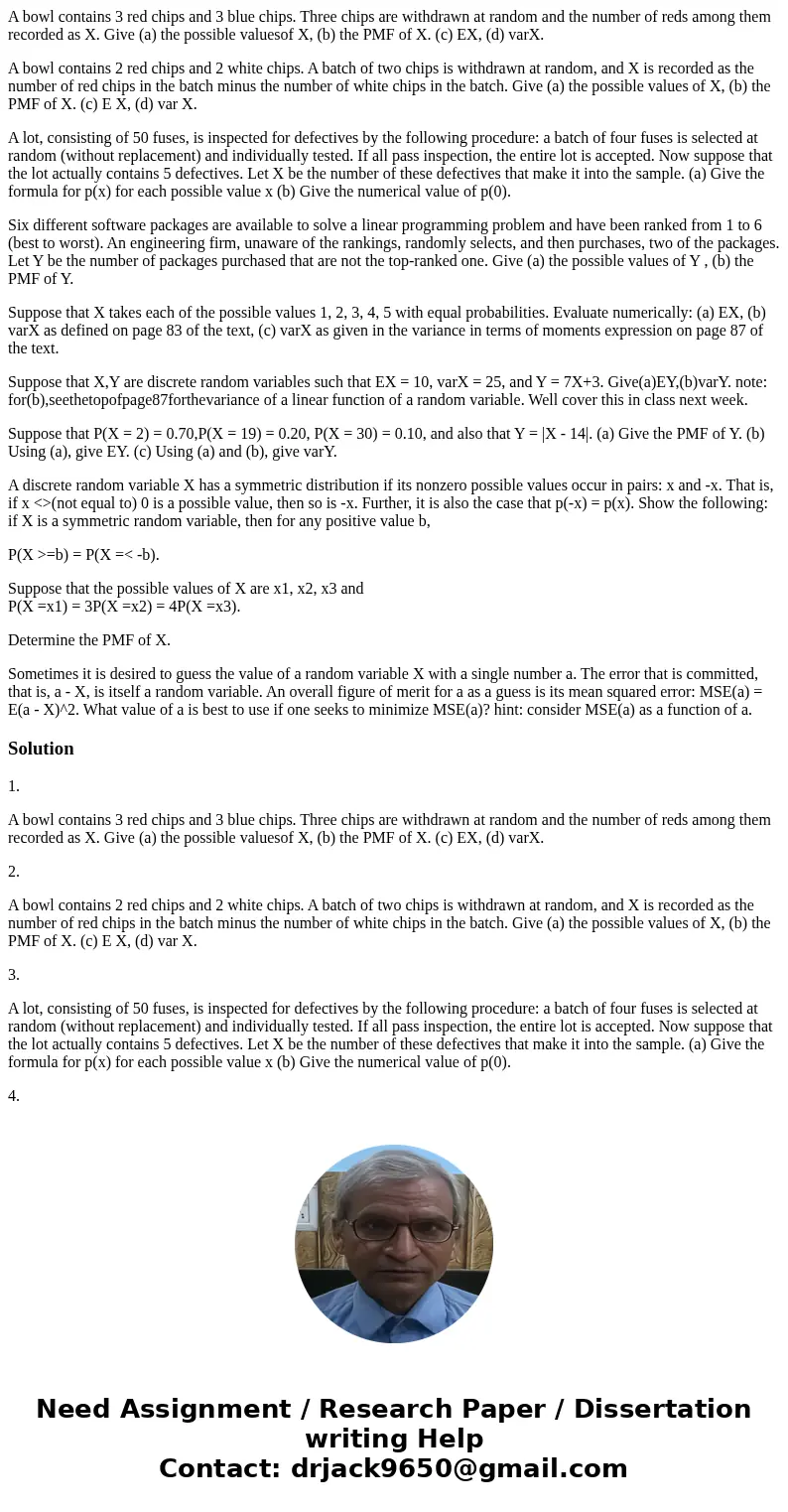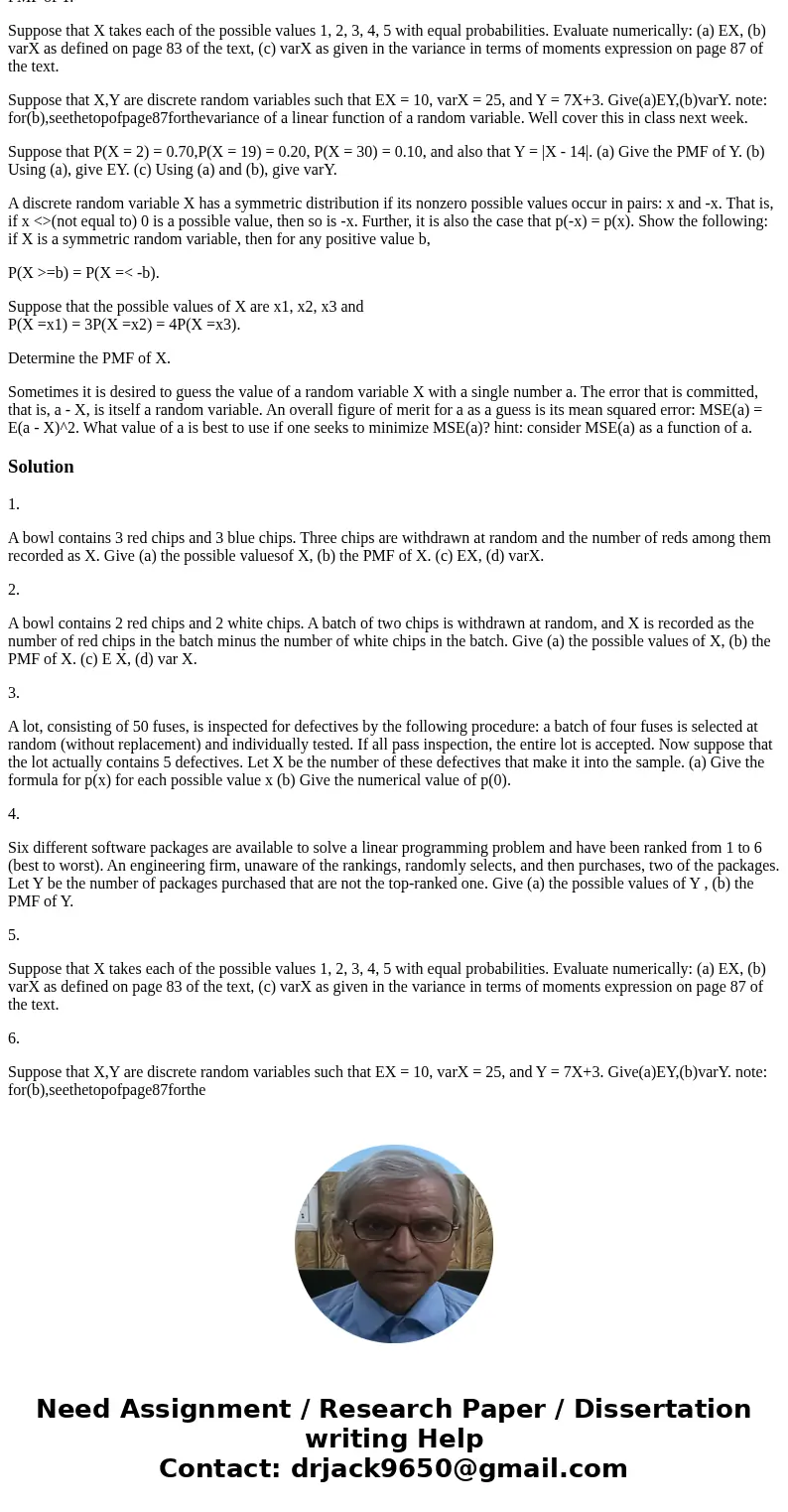A bowl contains 3 red chips and 3 blue chips Three chips are
A bowl contains 3 red chips and 3 blue chips. Three chips are withdrawn at random and the number of reds among them recorded as X. Give (a) the possible valuesof X, (b) the PMF of X. (c) EX, (d) varX.
A bowl contains 2 red chips and 2 white chips. A batch of two chips is withdrawn at random, and X is recorded as the number of red chips in the batch minus the number of white chips in the batch. Give (a) the possible values of X, (b) the PMF of X. (c) E X, (d) var X.
A lot, consisting of 50 fuses, is inspected for defectives by the following procedure: a batch of four fuses is selected at random (without replacement) and individually tested. If all pass inspection, the entire lot is accepted. Now suppose that the lot actually contains 5 defectives. Let X be the number of these defectives that make it into the sample. (a) Give the formula for p(x) for each possible value x (b) Give the numerical value of p(0).
Six different software packages are available to solve a linear programming problem and have been ranked from 1 to 6 (best to worst). An engineering firm, unaware of the rankings, randomly selects, and then purchases, two of the packages. Let Y be the number of packages purchased that are not the top-ranked one. Give (a) the possible values of Y , (b) the PMF of Y.
Suppose that X takes each of the possible values 1, 2, 3, 4, 5 with equal probabilities. Evaluate numerically: (a) EX, (b) varX as defined on page 83 of the text, (c) varX as given in the variance in terms of moments expression on page 87 of the text.
Suppose that X,Y are discrete random variables such that EX = 10, varX = 25, and Y = 7X+3. Give(a)EY,(b)varY. note: for(b),seethetopofpage87forthevariance of a linear function of a random variable. Well cover this in class next week.
Suppose that P(X = 2) = 0.70,P(X = 19) = 0.20, P(X = 30) = 0.10, and also that Y = |X - 14|. (a) Give the PMF of Y. (b) Using (a), give EY. (c) Using (a) and (b), give varY.
A discrete random variable X has a symmetric distribution if its nonzero possible values occur in pairs: x and -x. That is, if x <>(not equal to) 0 is a possible value, then so is -x. Further, it is also the case that p(-x) = p(x). Show the following: if X is a symmetric random variable, then for any positive value b,
P(X >=b) = P(X =< -b).
Suppose that the possible values of X are x1, x2, x3 and
P(X =x1) = 3P(X =x2) = 4P(X =x3).
Determine the PMF of X.
Sometimes it is desired to guess the value of a random variable X with a single number a. The error that is committed, that is, a - X, is itself a random variable. An overall figure of merit for a as a guess is its mean squared error: MSE(a) = E(a - X)^2. What value of a is best to use if one seeks to minimize MSE(a)? hint: consider MSE(a) as a function of a.
Solution
1.
A bowl contains 3 red chips and 3 blue chips. Three chips are withdrawn at random and the number of reds among them recorded as X. Give (a) the possible valuesof X, (b) the PMF of X. (c) EX, (d) varX.
2.
A bowl contains 2 red chips and 2 white chips. A batch of two chips is withdrawn at random, and X is recorded as the number of red chips in the batch minus the number of white chips in the batch. Give (a) the possible values of X, (b) the PMF of X. (c) E X, (d) var X.
3.
A lot, consisting of 50 fuses, is inspected for defectives by the following procedure: a batch of four fuses is selected at random (without replacement) and individually tested. If all pass inspection, the entire lot is accepted. Now suppose that the lot actually contains 5 defectives. Let X be the number of these defectives that make it into the sample. (a) Give the formula for p(x) for each possible value x (b) Give the numerical value of p(0).
4.
Six different software packages are available to solve a linear programming problem and have been ranked from 1 to 6 (best to worst). An engineering firm, unaware of the rankings, randomly selects, and then purchases, two of the packages. Let Y be the number of packages purchased that are not the top-ranked one. Give (a) the possible values of Y , (b) the PMF of Y.
5.
Suppose that X takes each of the possible values 1, 2, 3, 4, 5 with equal probabilities. Evaluate numerically: (a) EX, (b) varX as defined on page 83 of the text, (c) varX as given in the variance in terms of moments expression on page 87 of the text.
6.
Suppose that X,Y are discrete random variables such that EX = 10, varX = 25, and Y = 7X+3. Give(a)EY,(b)varY. note: for(b),seethetopofpage87forthe


 Homework Sourse
Homework Sourse